Delightful West Africa 11 – Casamance, Senegal
Ziguinchor, the capital of the Casamance, offers quiet walks in crumbling, leafy roads. The first time I take the camera out of the bag, a fruit seller pierces the air with her index finger: I may not photograph her, she indicates. She wasn't even in the field of view, but she needs to make the point. That's normal Senegalese behaviour, but very different from nearby Gambia: If you take out your camera in Gambia, people also raise their hands – to arrange hair for the happy occasion.
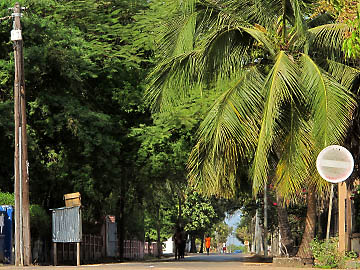
|
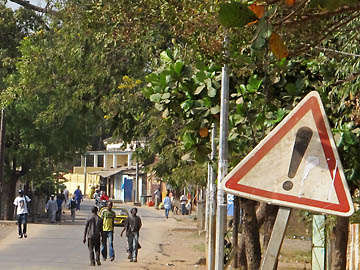
|
As the whole of Casamance, Senegal's southernmost province, Ziguinchor is a big mix of cultures. Islam is only one of several religions here, there are many Christians and animists as well. I hear few prayer calls, and from afar – a new Senegalese experience. Taxi drivers and clothes shops play not only Senegalese Mbalax pop, but also hiphop, Celine Dion in French and cheesy pop from nearby Guinea-Bissau. The majority belong to the Jola (Diola) tribe and these people are considerably more relaxed and unobtrusive than the Mandinkas or Wolofs further north in Gambia or Senegal. If you see Chiang Mai and its surroundings as a soft introduction to Thailand, then Ziguinchor and the Casamance might be a soft introduction to Senegal.
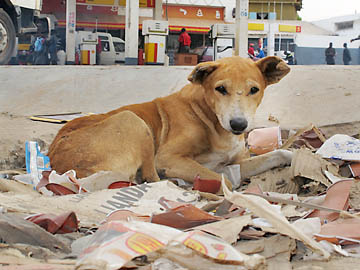
|
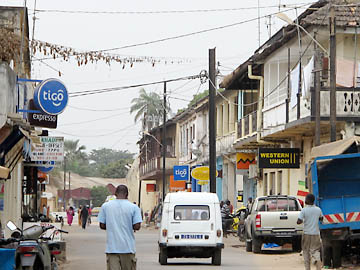
|
***
Ziguinchor has a fleet of grubby taxis which always drive with open windows. Nobody uses the safety belts in town, and for good reason: If you do don the safety belt, you'll get a diagonal brown dirt track across your nice evening shirt.
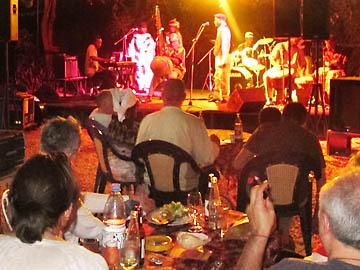
|
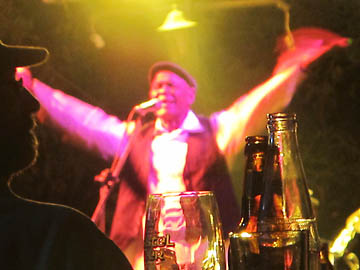
|
***
Like Saint-Louis (see West Africa part two), Ziguinchor boasts a French cultural center. I have of course timed my arrival in town for the weekend. In the cultural center's garden, I hear a concert with Le Baaduwaa Orchestra. The nine-piece band plays clean, complex Senegalese pop with immaculate sound, even the 21-string-kora (West African harp) remains perfectly recognisable.
The entry is 1,5 Euro. The cultural center's excellent CD compilation with Casamance musicians is eight Euro. On my garden table with good stage view, I also have fish and rice, a large extra salad and a local beer; the restaurant bill amounts to five Euro. Anywhere else in town you'd pay the double price.
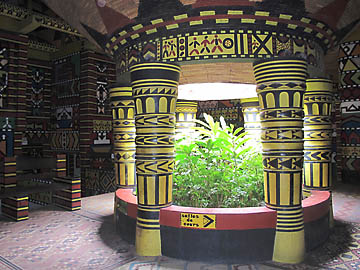
|
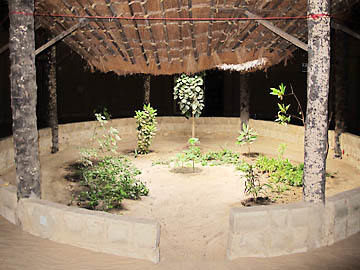
|
— Cases À Impluvium —
All over the Casamance you find these impressive mud buildings with their thatched roofs. They have a unique system to catch rain water. The rooms are built in a circle with an empty round patio in the middle. As the Lonely Planet guide book describes: "Its roof slopes in the middle, channeling drops into a basin." This also creates a tunnel of light reaching the center of the building.
The rain water does not fall directly into a well, but lands in a flat pan in the building's center, often decorated with flowers. From there the water flows through a plughole into the subterranean cistern.
I see many stunning cases à impluvium – traditional houses still inhabited by families, traditional houses converted to simple lodges (as in Enampor) and newly-built cases à impluvium that also function as lodges (as the Aljowe in Oussouye and the campement in Seleki). The most striking example is the Alliance Franco-Senegalese in Ziguinchor with even two light-water funnels and wall-to-wall African art.
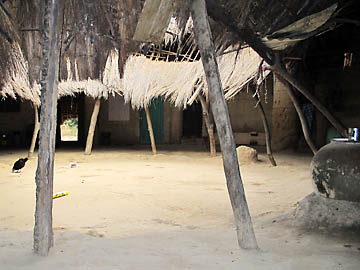
|
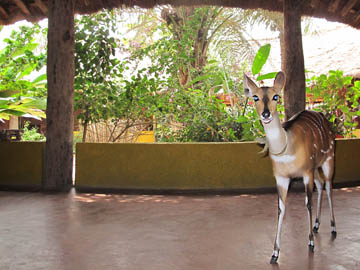
|
— Oussouye —
Oussouye is a large village with a few simple lodges, so-called campements – nice homes in the wilderness for pothole research in Senegal's deep south, the delightfully green and leafy Casamance area. Best of all, Oussouye has VTT Casamance, an agency that organizes guided countryside tours and rents out decent mountain bikes (ten Euro per day). There are a few tourists, yet no pushers or beggars at all. With my go-anywhere bicycle, the reasonable easygoing people, agreeable accommodation and restaurants, I feel more free than anywhere else in Senegambia.
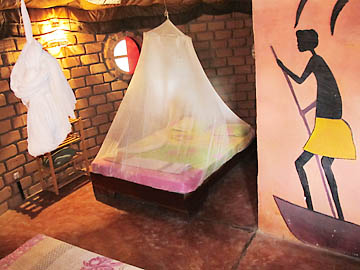
|
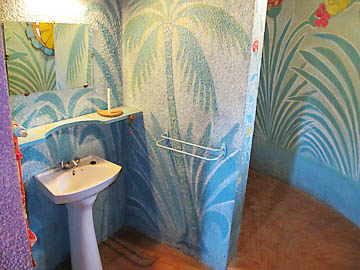
|
***
I am alone in the last room of my contorted, basic so-called apartment in the Campement Aljowe (10,5 Euro per night). Suddenly I hear a slight noise from the room that's closer to the main corridor. I even see a shadow moving.
"Who is there", I shout angrily. I don't think that Ouzin, the friendly receptionist, plays any tricks with me. I believed there were no other people present in the guesthouse.
No more sound, no more shadow. I am a little scared, even though Senegalese villages are considered very safe.
Rapidly I fully open the door to the room with the miraculous shadow and sound and look into the eye of an – antelope. Yes, it's the Aljowe's tiny nyala antelope on a first visit. I haven't noticed it when I checked in.
The antelope, sized like a bigger goat, looks quietly back at me. Only with some effort I maneuver the animal out of my apartment and back into the communal area.
Ouzin appears. "Be careful", he warns, a little late maybe, "our antelope eats all kinds of papers and materials, including passports and t-shirts".
Later I observe that the antelope doesn't discriminate potted flowers and hammocks either.
"Be careful", I warn Ouzin, "your antelope eats your whole inventory. Better you eat the antelope first. She looks quite a lunch."
"Non, I couldn't", Ouzin shudders.
The antelope is on friendly terms with the lodge's dog and cats. One of the cats wants to be on friendly terms with me. Returning late one night, I find the cat on my bed. I have no idea how the feline got into my apartment, but kick it out immediately.
The next night I hear noise from the roof construction. Has a dove landed? A rat rambling? No, yesterday's cat peeps through a hole in the lowest ceiling level, two meters above me. So that's its access. I throw Graham Greene's "The Heart of the Matter" at the cat (the PETA-approved softcover edition). The bookmark alights in mid-air, but the cat disappears for good.
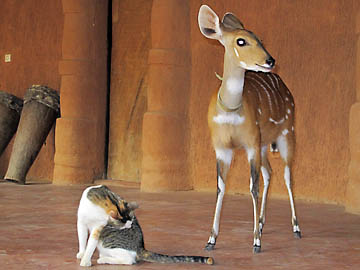
|
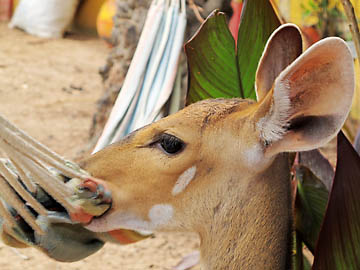
|
***
The Les Bolongs guest house is in Edioungou village, four kilometers from my Oussouye lodge on a delightfully leafy sand track – nicely doable on rental mountain bike. Les Bolongs has a large, breezy first floor restaurant terrace overlooking peaceful mangroves and river arms; they are renowned for good food (entrée, main and fruit nine Euro); they serve real coffee; they have hammocks for your after lunch siesta; there are no cars or machines nearby.
In short, the Les Bolongs restaurant terrace is almost village heaven on earth.
And then they go and spoil it all by doing something stupid like turning on the TV loudly and changing channels continuously.
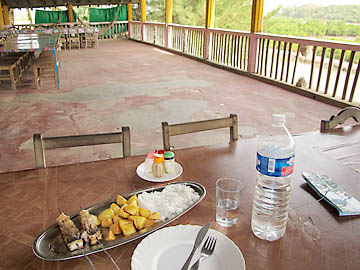
|
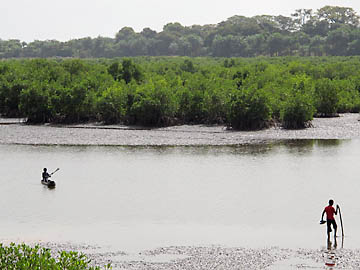
|
***
At Oussouye's almost delightful open-air Bar Le Rond-Point (run by the same family as Les Bolongs) they never tell you what they have. You must ask. By try-and-error I've discovered that they do a decent espresso.
"Could you do a breakfast", I ask one morning?
"But of course!"
"Okay then, one breakfast." In frenchised Le Sénégal, that will always be coffee, bread, butter and jam.
"But, monsieur, what do you want for breakfast?"
"Oh, just give me a big espresso, bread and butter."
"Avec plaisir."
A man I've never seen before takes my handsome rental bicycle and pushes onto the road.
Hans: "Monsieur, monsieur, attendez, excusez-moi, where are you going with my bicycle?"
Man: "Why, you ordered butter, so I have to fetch it from the market, it's too far to walk."
Ten minutes later, my breakfast starts with a big espresso, white bread and a 250-gram block of butter.
***
A robed African lady floats by. She transports one mango on her head.
***
Cripples in wheelchairs roll by. They don't even look at the white man, I feel neglected. Don't they know what begging is?
— Guided Trips —
My first guided village excursion on mountain bike follows shady, sandy footpaths across several villages with yellow mudbrick houses – wonderful riding, lush green-covered villagescape shaded by enormous trees, and impossible to find without a guide. Three hours including guide and bicycle for only me are 15 Euros. Passing through villages, we greet "Kasumay" in Jola. In a dead river arm, locals fetch small fish out of the shallow water as if collecting sea shells.
The trip includes one visit to a case à impluvium (see above). It is a family home, but they also sell all kinds of tourist knick-knack. I kick my guide out of there – I've had enough of wooden masks, "naïve art" and covered sales talk since ten African weeks ago. Only at this one house children beg for sweets and behave generally unpleasant.
After the trip, the guide greases the chains, then takes the waterhose. "Wouldn't it be better to hose first, then put the grease", I ask? This is dismissed. He hoses the bicycle and a lot of black grease drips into the soil. The next day he changes the order.
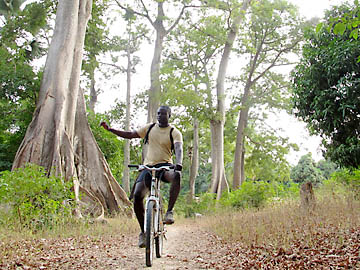
|
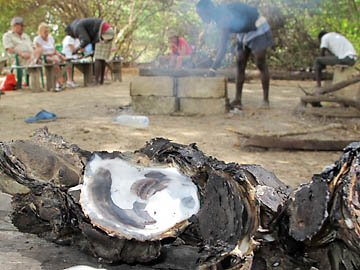
|
***
That next bicycle outing has more lush green villagescape and easy to ride footpaths of blonde sand. We lunch at a remote, simple guesthouse on a riverside. To my surprise, it is one of the best meals I ever had in Africa and they even pour real espresso. But then I note that more tour groups stop by – and they are not only so-called eco-tourists from Oussouye or Ziguinchor, like me, but also rich package tourists from Club Med and other resorts at the renowned Cap Skirring beaches with its non-stop flights from Paris.
We also get freshly cut mangrove sticks full of oysters. The sticks go into the fire for a short while, then we open the oysters with knifes and eat the meat. I believe it's a delicacy to some, and the rich French wash the oysters down with a good blanc.
The water body here is a typical Gambian/Southern Senegalese "bolong": a river so wide and quiet that it looks like a Scandinavian lake, lined by mangroves, full of fish jumping with joy. The kayak trip also shows lots and lots of oysters. Otherwise the riverbank is just another green wall. The guide can't believe it when I tell him to turn around and cut the kayak trip short – but I prefer some time in the hammock under the trees.
On the narrow forest track, guide Yves drives ahead on his bicycle and explains something in French. I don't understand him, as 1) he talks in the wrong direction while riding a bicycle, 2) I have to concentrate on the track and 3) I don't understand so much French anyway. I follow Yves on my bicycle.
Hans: "Sorry, I don't understand you now. Let's talk more when we stop somewhere."
Yves: "What? What?"
Hans: "I said I don't understand you now. Let's talk more at the next stop."
Now the guide gets my point. He changes his topic.
***
More villagescape on the third mountain bike trip. We see the tedious process of cashew nut processing which includes cooking and roasting; the Indian peeling machine is better than the competing Brazilian construction. The farmer, Joseph, a retired government official, obviously set the operation up to support unwed mothers and the handicapped. One supposedly unwed mother stares at me intensely during my 40 minutes on the premises.
The tour description also includes a stop at a local pottery. I refuse to go inside as I am now tired of African handicraft and all the covered sales talk. Instead I suggest another stop at Les Bolongs, where I know they have bissap juice today (more on bissap juice in West Africa, part 9). My guide Yves orders a beer.
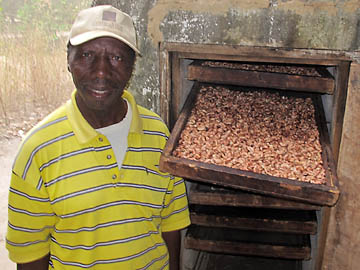
|
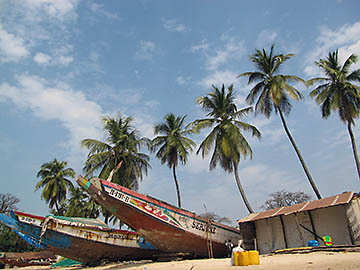
|
— Île de Carabane —
Carabane island sits in the wide Casamance river delta, close to the Atlantic ocean. The public pirogue (like a Thai longtail boat) from Elinkine on the mainland should leave around 2.30 p.m. for 1,5 Euros. At 2 p.m., my name is written into a book. At 2.45 we have only gathered ten of the 21 required passengers.
I decide to take a private boat for 25 Euro. The dreadlocked boatman walks home to fetch the engine. I can see how he leasurely talks to everybody on his way.
The boatman comes back with the machine. Boatman, helper and I sit down in the boat. Boatman and helper climb out again and walk back to the road, I am left alone in the boat without explanation. Obviously they try to chat up other customers on the road. "My friend", I call and motion the boatman to get started. He gestures back that everything will happen in due time.
Boatman and helper arrive, the engine is started. We depart.
We land again 300 meters west of the starting point. "To buy gasoline", explains the boatman and asks for an advance.
The boatman and the helper step out of the boat and discuss the required amount for ten minutes. Should they buy gasoline for 5,5 or 7 Euro?
The helper walks off with a canister to fetch gasoline for 5,5 Euro.
Next to me on the sand, the boatman produces his penis and urinates against the boat while drowning me in talk.
The boatman gives small change to a small boy to bring cigarettes.
After 15 minutes, the helper with the gasoline arrives.
The boy with the cigarettes does not arrive. The boatman shouts after the boy.
After five more minutes, the boy arrives with three cigarettes.
We depart again, this time for good. The boatman drowns me in talk for 30 minutes.
We arrive at Île de Carabane. Because of low tide, we have to walk 50 meters through knee-deep water to the shore. I am prepared for getting wet, but while packing in Oussouye, I've made a bad mistake: the money-belt with passport, credit cards and Euro cash is not around my waist, but still in the big suitcase. The boatman puts the suitcase including my passport and money onto his head and wades to the shore. I follow closely. We make it safely to dry land. (For my departure from Île de Elinkine, see the next submission.)
***
Île de Carabane has a small string of about five guesthouses and restaurants. I have opted for the self-declared Hotel Carabane. Like other African lodges, it has an external corridor leading along all guests' sleeping room windows. I don't like that design at all, but like always, the Lonely Planet guide book doesn't mention the unfortunate architecture. I am lucky: In the Hotel Carabane, I manage to secure a room at the far end of the row, nobody else will pass there. This gives me more privacy and an extra window, because there is no more neighboring room. I get even more: The generator noise from the backyard in the evenings.
***
In a small tourist restaurant on the beach, I order an omelet sandwich.
After 25 minutes, word reaches me from the kitchen that they have no bread. I agree to take only the omelet.
After another 45 minutes, a greasy omelet reaches me.
***
I spend only two nights on tiny, remote Île de Carabane, but there's live music at the Badji Kunda backpacker resort on my first evening, maybe the only local event in the whole year. Lamine Sissikho on the kora (21 string West African harp) and seven musicians play the rhythmical, distinctly West African "kora music" that I have already seen live from kora master Jaliba Kuyateh in Gambia (described in my upcoming Gambian submissions). This music goes straight to the West Africans' hearts.
The entry is 0,8 Euro, soft drinks are 0,8, local beers 1,5 Euro. The mixed black-white audience in the Badji Kunda's "bamboo garage" restaurant gets soon up dancing. As so often, French and Senegalese mix exceptionally well. Egalité and fraternité are celebrated over many pastis.
The sound is quite clear, much better than from the supposedly richer Jaliba Kuyateh. As in Thailand, musicians who play for a local audience always play up very convincingly. This audience includes dignified African ladies in their best robes with fitting headties, hearding three or five little children each around their feet. As the music heats up, these African ladies storm the dance area. They bow deep down until their hind end is the highest body part. And then they do things with their derrières you simply don't expect from muslim fisherwomen at the end of the world.
Next morning I see the band members loading all their loudspeakers, drums and instruments across the sand and water into a pirogue (like a Thai longtail boat). Boss Lamine Sissikho says he is a griot by profession, a West African praise singer. As such, he doesn't help loading the pirouge, the drummer must carry his heavy kora. He asks if I could arrange concerts for him in Europe, but so far hasn't even produced one CD. Finally the open boat, overloaded with people and stage equipment, putters away down Casamance river.
***
Reader, thanks for joining me all the way to the Casamance, Le Sénégal's southernmost and last destination. To get to the Casamance, I traveled from Senegal's northern half through The Gambia, a country that almost splits Senegal in two; then I left The Gambia to the south to re-emerge in Le Sénégal, in the Casamance region; from the Casamance I later returned north to The Gambia. The next article will recount my entertaining land border crossings between Senegal and Gambia. After that, I'll be back with reports from Gambia proper, a country enclosed by only Senegal and the Atlantic Ocean. Gambia has basically the same races and cultures as Senegal. Still due to its British colonial history and differing government style, Gambia feels partly unlike francophone Senegal. In some aspects, Gambia seems more developed, in others it lags behind. Also important: A more relaxed attitude and wide-spread good English facilitate friendships in The Gambia. Learn more in the upcoming submissions.
Stickman's thoughts:
Very nice – and I laughed loud at the way the butter was served with your breakfast!



